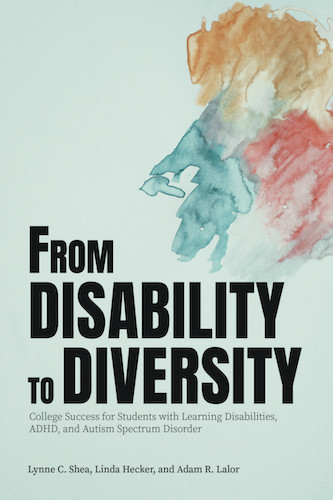From Disability to Diversity: Adventures in Book Writing by a Veteran Teacher
By Linda Hecker
As I prepared to retire on my 70th birthday two years ago, I could not only look back with amazement at my 32 years at Landmark College, but ahead to one of the greatest challenges of my professional life: writing a book. Yes, I had written articles, delivered workshops, created courses and even written book chapters earlier in my career. But what would persuade a well-worn retiring educator to exchange mocha lattes by the pool for the daily grind of researching and writing an academic book? 
To put it simply: I was drawn to the challenge of making sense of what I learned over my long career at Landmark and disseminating it in a form that might make a difference to future students and the professionals who support them. It helped to have two dedicated Landmark colleagues as co-authors, Lynne Shea (Dean of Liberal Studies and the Arts), and Adam Lalor (lead education specialist with Landmark College Institute for Research and Training.) We helped each other stick to production schedules and re-think difficult topics. It was motivating to know that we had a publisher eager to promote the finished book, as well as contractual deadlines to meet.
Although it took almost two years from initial proposal to publication, we now contemplate with satisfaction and some pride From Disability to Diversity: College Success for Students with Learning Disabilities, ADHD, and Autism Spectrum Disorder. It encompasses many of the ideas that make Landmark College an exceptional learning environment for students who learn differently, but adapts them for application at colleges that are not specialized. We wanted to “provide useful information for those working in postsecondary contexts who are not yet experts in supporting these students,” (vii) as well as a layperson’s overview of recent advances in neuro-cognitive research and social justice advocacy that undergird the approaches we promote.
Our most important message: when educators shift their mindset from a disability framework to one of diversity, it becomes clear that students who learn differently have much to contribute to academia by virtue of their unique strengths and perspectives. In our book we often let the students speak for themselves, highlighting their voices and insights, and those of the professionals who work with them.
Our book espouses a philosophy of universal design for education, arguing that “accessibility means moving beyond the current accommodations model to create environments that are learner-friendly to as many students as possible (vii),” in classrooms and across the campus. To that end, we introduce the concept of Cognitive Ramps, instructional approaches that open pathways to learning not just for students who learn differently, but to a wide range of learners from many backgrounds, in the same way that replacing a set of stairs with a ramp benefits not just wheelchair users, but anyone with a stroller, rolling suitcase, bicycle, or tired feet. We apply our understanding of Cognitive Ramps to the co-curricular context as well as the classroom experience.
Some examples of academic Cognitive Ramps explored in the book are the Technology Tools for Reading and Writing, summarized in a table on p. 51. Although these tools specifically benefit students with language-based disabilities such as dyslexia and dysgraphia, their flexibility offers any student many options for customizing the reading or writing process to suit individual needs or preferences. Providing multiple formats for students to access course content and demonstrate learning (hard copy text, digital text, online readings, charts, diagrams, video, blogs, webinars) are additional examples of Cognitive Ramps that are discussed in Chapter 4, “Supporting Students with LD in the Classroom,” which includes a section focused on online courses and environments.
Type of Tool |
Purposes |
Examples |
|---|---|---|
Text-to-speech |
Reads text out loud with variable speeds and voices to promote fluency, comprehension, attention and reading stamina |
|
Voice recognition |
Transcribes speech into digital text to bypass difficulties with spelling, keyboarding or handwriting |
|
Graphic organizers |
Create mind maps to generate and organize ideas and visually show relationships among concepts. Supports both note-taking and organizing ideas for writing. |
|
The book is full of practical recommendations for enhancing educational success for students with language-based learning disabilities, ADHD, and on the Autism Spectrum outside the classroom, too. We discuss special considerations for advising, coaching, extra-curricular activities, conduct, health and wellness, and residential life issues that impact students who learn differently over and above their neurotypical peers. We specifically address the implications of the recent uptick in students with ASD on campuses across the country.
Now that the book is published and available for purchase, will I rest on my laurels and forego academic writing for the next few years?
Absolutely, yes. And make that a double latte, please.